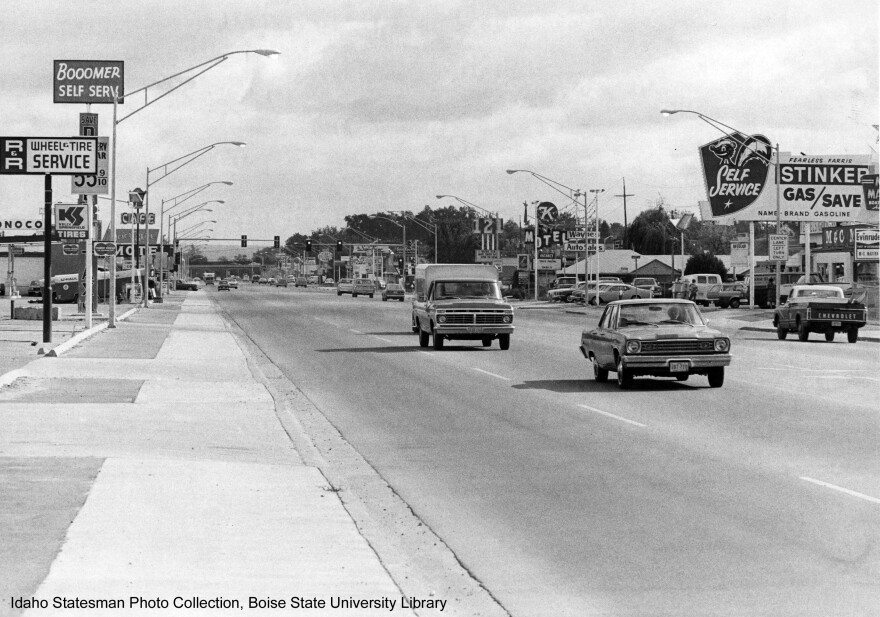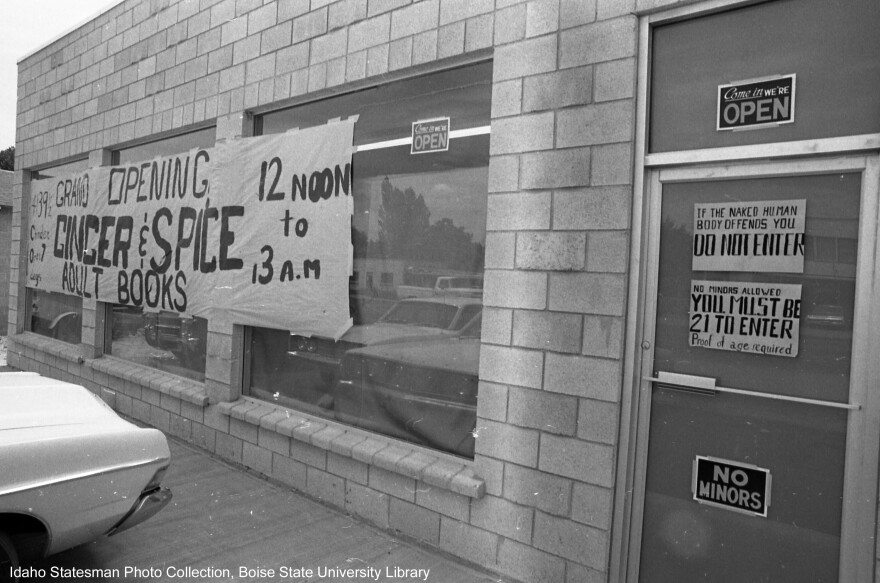Hay fields, vegetable gardens, and slot machines: There are several milestones that mark the timeline of tiny Garden City. This four mile burg, surrounded by much larger cities like Boise, has had a stop-and-start history.
The early history of Garden City is hard to come by. We do know the land caught the eye of the U.S. Army in 1863; Idaho historian Susan Stacy says that’s when soldiers came to the Treasure Valley to build Fort Boise. And with the Army came hungry horses.
“There was this big island in the Boise River and it was called Government Island because the Army assigned that land, 600 or 700 acres, to growing hay for the horses the Army had with it,” Stacy says.
The channel of the Boise River was different back then, and Government Island included the area where Garden City sits today. Over time, the government had less use for horses, and no longer needed a hay reserve. Stacy says in 1884, the Army started selling off Government Island.
Around this time, a man named Tom Davis came to Boise to mine gold in the Boise Basin. Stacy says he quickly branched out, buying up land, planting apple trees and vegetables, and selling them to residents. He also got in the cattle business in the 1880’s. Like the Army, he needed a place to grow hay, so in 1888 Davis got interested in Government Island.
“So he started assembling that land, he started buying parcel by parcel by parcel,” says Stacy. “And by 1890, he had assembled about 650 acres, which is the majority of what we now know as Garden City.”
Davis set up the Government Island Ranch and started growing hay. Stacy says Davis was not only an entrepreneur, but he had friends who happened to be Chinese. This was during a time when the Chinese were not treated well by most whites.
“I don’t think he shared the denigration or the prejudice," Stacy says. "I think he admired their enterprise and admired their work and their results."

Many of the Chinese had been drawn to the area's gold mines in the 1860’s. The immigrants found little gold so some turned instead to farming. Davis leased some of his land to Chinese gardeners.
“That’s where the reputation of the Chinese Gardens in Garden City began because they were enterprising their leased parcels,” Stacy says.
Davis died in 1908 and his children took over the estate. They initially kept the ranch and the arrangement with Chinese farmers continued. Idaho historian Arthur Hart says Chinese gardeners made a good living in the area.
But over time, the ranch was sold off and the Chinese gardeners began to disappear. But Hart says they left an indelible stamp on Garden City.
“So when they named their streets, Chinden Boulevard is a contraction of Chinese Garden.”

Gambling Comes To Garden City
The next notable chapter in Garden City's history came in 1947. The Idaho Legislature passed a law allowing “coin operated amusement devices” - otherwise known as slot machines.
“The legislature in its wisdom, decided to allow local option on gambling,” Hart explains.
Any city or incorporated village could get a license from the state and start gambling. Boise voted against slots. But Hart says some saw an opportunity in the land just west of Boise.
“Some really smart guys decided ‘O.K., we’ll start our own town and then you and me and Charlie are going to vote in local option and we’re going to go for gambling.’ So they did,” says Hart.
And with that, Garden City was born in 1949. The town quickly became a mecca for gamblers.
Hart remembers driving to Garden City with friends.
“Not to gamble, but to take advantage of the strawberry shortcake (for) five cents, stuff like that,” Hart remembers. “They were giving it away to get people in the door.”
Garden City began to thrive. The Circle M, Hi Ho Club and others like them sat right next door to much bigger Boise, drawing customers who couldn’t find slots just a few miles away in the capital city.
Garden City government got a cut of the profits from slots and put them to good use. An August 1951 article in Life Magazine showed that soon there was a $10,000 park and playground, a new water system, city hall, and a police force - all paid for by gambling.
But Hart says the honeymoon ended in 1953.
“Somebody noticed the constitution and that the Legislature had no power to go against the constitution without amending the constitution, which they didn’t. At that time, gambling was still illegal.”
There were those in Idaho who considered slot machines immoral. That lead to the lawsuit. It went all the way to the Idaho Supreme Court. The Court ruled that slot machines were lotteries and lotteries were illegal under the Idaho Constitution, along with being ‘a well-recognized evil and mischief.’
Any building where gambling took place was declared ‘a moral nuisance’ and had to be closed down. Garden City would have to reinvent itself or risk going out of business.

The city responded by becoming more business friendly. City leaders relaxed building codes, leading to a mish-mash of homes and businesses. The city welcomed all types of business, even the less desirable ones. This included junkyards, slaughterhouses, nightclubs and adult bookstores. It all lead to Garden City earning the nickname, ‘Saturday Night Town.’
“They thought we had a prostitute behind every bush," says longtime resident Donna "D.J." Conn. "They called us, and I won’t say this again, but they called us Garbage City.”
Conn has lived in the city since 1956. She worked for the local newspaper, got into politics, and is a champion of the community. Her family was originally attracted by the cheap land, and relaxed building codes.
“You could buy a 50-by-150-ft. lot for $100 down, it cost $1000," Conn says. "And you could pay $10 a month if you wanted to."
She and her husband bought land and started raising kids. Her daughter, Patricia, grew up in Garden City in the 1960’s. Patricia says the city had a rough and ready reputation during this period.
“Nothing was regulated and people liked that," Patricia says. "Here you could come on down with your chickens and your horses and your pigs and whatever. You could get a tarpaper house going. Slowly Garden City got out of that."

Changing Priorities
The 1970s were a decade of mobile home parks. Houses from the 40’s were torn down to make way for mobile homes. Families moved in and decided to stay. Patricia says priorities changed, and over time, the city added more regulations.
“Garden City grew up very slowly, and sometimes with a lot of kicking and cussing," she says. "But we grew up the way we wanted to and it was because people got involved in their government."
Her mother and father were pioneers in city government, serving on the city council and planning and zoning commission.
By the 80’s, Garden City was sprucing up. Over the last 25 years, the city has made an effort to develop new housing, especially along the Boise River. The city also kept close ties to local businesses, encouraging them to grow.
Donna Conn says there are still growing pains, but more people are taking pride in Garden City.
“It’s a good place and people are coming in and we’re enjoying the town,” Donna Conn says.
Find Samantha Wright on Twitter @samwrightradio
Copyright 2015 Boise State Public Radio




